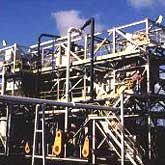Our Most Abundant Fossil Fuel
 Coal is our most abundant fossil fuel. The US has more coal than the rest of the world has oil. There is still enough coal underground in this country to provide energy for the next 200 to 300 years. But coal is not a perfect fuel. Trapped inside coal are traces of impurities like sulfur and nitrogen. When coal burns, these impurities are released into the air. While floating in the air, these substances can combine with water vapor (for example, in clouds) and form droplets that fall to earth as weak forms of sulfuric and nitric acid scientists call it 'acid rain.' There are also tiny specks of minerals mixed in coal. These tiny particles don't burn and make up the ash left behind in a coal combustor. Some of the tiny particles also get caught up in the swirling combustion gases and, along with water vapor, form the smoke that comes out of a coal plant's smokestack. Some of these particles are so small that 30 of them laid side-by-side would barely equal the width of a human hair!
Coal is our most abundant fossil fuel. The US has more coal than the rest of the world has oil. There is still enough coal underground in this country to provide energy for the next 200 to 300 years. But coal is not a perfect fuel. Trapped inside coal are traces of impurities like sulfur and nitrogen. When coal burns, these impurities are released into the air. While floating in the air, these substances can combine with water vapor (for example, in clouds) and form droplets that fall to earth as weak forms of sulfuric and nitric acid scientists call it 'acid rain.' There are also tiny specks of minerals mixed in coal. These tiny particles don't burn and make up the ash left behind in a coal combustor. Some of the tiny particles also get caught up in the swirling combustion gases and, along with water vapor, form the smoke that comes out of a coal plant's smokestack. Some of these particles are so small that 30 of them laid side-by-side would barely equal the width of a human hair!
Also, coal like all fossil fuels is formed out of carbon. All living things are made up of carbon. Remember -coal started out as living plants. But when coal burns, its carbon combines with oxygen in the air and forms carbon dioxide. Carbon dioxide is a colorless, odorless gas, but in the atmosphere, it is one of several gases that can trap the earth's heat. Many scientists believe this is causing the earth's temperature to rise, and this warming could be altering the earth's climate. Sounds like coal is a dirty fuel to burn. Many years ago, it was. But things have changed. Especially in the last 20 years, scientists have developed ways to capture the pollutants trapped in coal before the impurities can escape into the atmosphere. Today, we have technology that can filter out 99 percent of the tiny particles and remove more than 95 percent of the acid rain pollutants in coal. We also have new technologies that cut back on the release of carbon dioxide by burning coal more efficiently.
Many of these technologies belong to a family of energy systems called 'clean coal technologies.' Since the mid-1980s, the U.S. Government has invested more than $2 billion in developing and testing these processes in power plants and factories around the country. Private companies and State governments have been part of this program. In fact, they have contributed more than $4 billion to these projects.
Fact Credit
DOE Department of Energy


